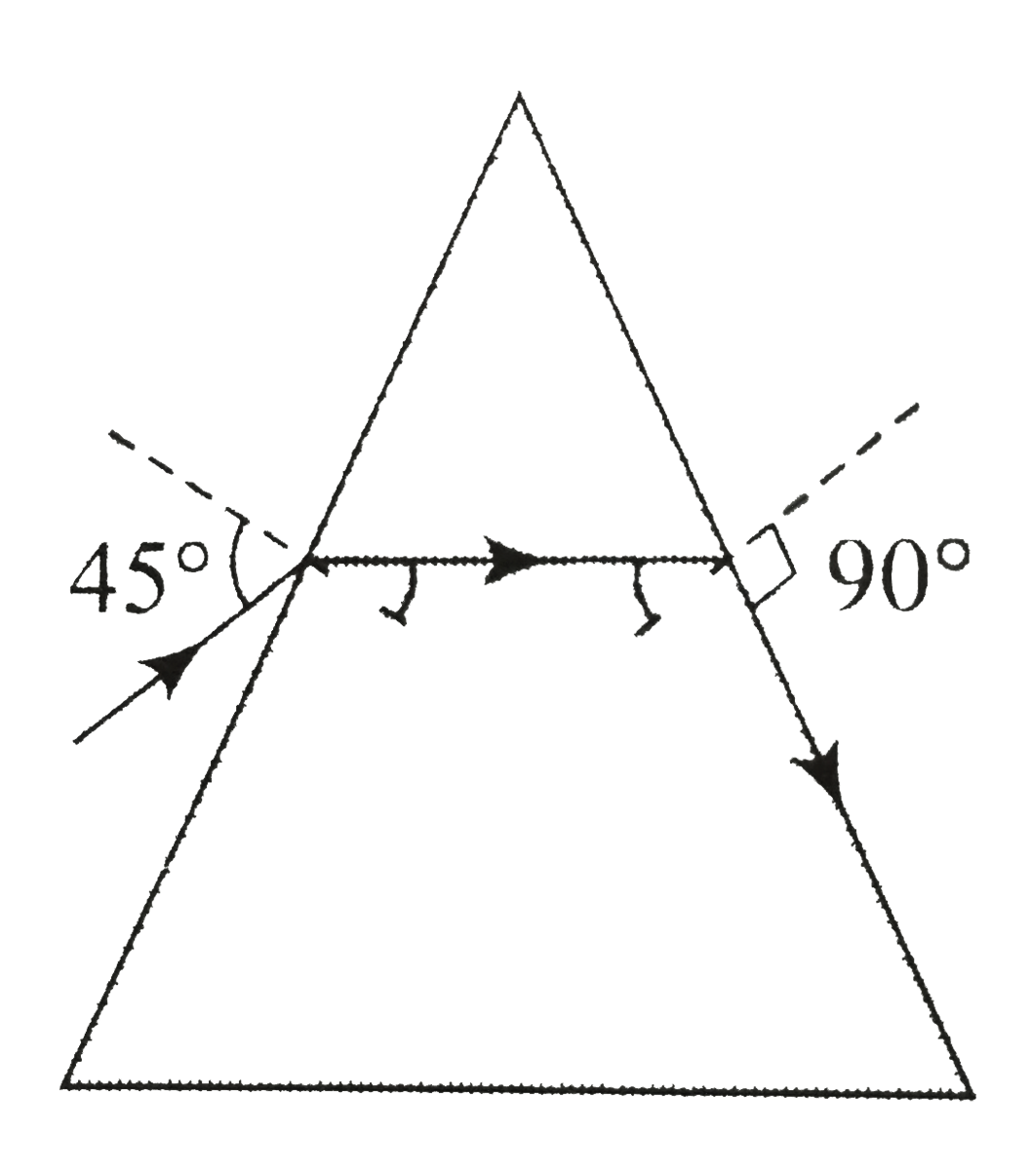A ray of light is incident at small angle I on the surface of prism of small angle A and emerges normally from the oppsite surface. If the refractive index of the material of the prism is mu, the angle of incidence is nearly equal to
A/μ
A/(2μ)
μA
μA/2
The correct Answer is:C
To solve the problem, we will follow these steps:
Step 1: Understand the Geometry of the Prism
We have a prism with a small angle A. A ray of light is incident on one surface of the prism at an angle I and emerges normally from the opposite surface.
Step 2: Identify the Angles
- Let I be the angle of incidence.
- Let A be the angle of the prism.
- Let E be the angle of emergence, which is given as 0 because the ray emerges normally.
Step 3: Use the Relation for Angle of Deviation
The angle of deviation D can be expressed as:
D=I+E−A
Since E=0, we can simplify this to:
D=I−A
Step 4: Relate Angle of Deviation to Refractive Index
The angle of deviation can also be expressed in terms of the refractive index μ and the angle of the prism A:
D=μ−1⋅A
Step 5: Set the Two Expressions for Angle of Deviation Equal
From the two expressions for D:
I−A=μ−1⋅A
Step 6: Rearranging the Equation
Rearranging gives:
I−A=μA−A
This simplifies to:
I=μA
Conclusion
Thus, the angle of incidence I is nearly equal to:
I=μA
Final Answer
The angle of incidence is nearly equal to μA.
---
We have a prism with a small angle A. A ray of light is incident on one surface of the prism at an angle I and emerges normally from the opposite surface.
- Let I be the angle of incidence.
- Let A be the angle of the prism.
- Let E be the angle of emergence, which is given as 0 because the ray emerges normally.
The angle of deviation D can be expressed as:
D=I+E−A
Since E=0, we can simplify this to:
D=I−A
The angle of deviation can also be expressed in terms of the refractive index μ and the angle of the prism A:
D=μ−1⋅A
From the two expressions for D:
I−A=μ−1⋅A
Rearranging gives:
I−A=μA−A
This simplifies to:
I=μA
Thus, the angle of incidence I is nearly equal to:
I=μA
The angle of incidence is nearly equal to μA.
Topper's Solved these Questions
- RAY OPTICSBOOK - DC PANDEY ENGLISHCHAPTER - RAY OPTICSEXERCISE - A. Only one option is correct (JEE Advance)
73 Videos
- RAY OPTICSBOOK - DC PANDEY ENGLISHCHAPTER - RAY OPTICSEXERCISE - B. More than one option is correct
20 Videos
- PROPERTIES OF MATTERBOOK - DC PANDEY ENGLISHCHAPTER - PROPERTIES OF MATTEREXERCISE - Integer
8 Videos
- ROTATIONBOOK - DC PANDEY ENGLISHCHAPTER - ROTATIONEXERCISE - (C) Chapter Exercises
39 Videos
Similar Questions
A ray is ihncident at an angle of incidence ii on one surface of a prism of small angle A and emerge normally from opposite surface. If the refractive index of the material of prism is μ. the angel of incidance I is nearly equal to
View SolutionA ray of light is incident at 60∘ on one face of a prism of angle 30∘ and the emergent ray makes 30∘ with the incident ray. The refractive index of the prism is
View Solution
Knowledge Check
A ray of light is incident at 60∘ on one face of a prism of angle 30∘ and the emergent ray makes 30∘ with the incident ray. The refractive index of the prism is
A1.732B1.414C1.5D1.33
A monochromatic light is incident at a certain angle on an equilateral triamgular prism and suffers minimum deviation . If the refractive index of the material of the prism is √3, them the angle of incidence is :
View SolutionA ray of light is incident at 65∘ on one face of a prism of angle of 30∘ and the emergent ray makes 35∘ with the incident ray. The refractive index of the prism is:
View SolutionThe light ray is incidence at angle of 60∘ on a prism of angle 45∘ . When the light ray falls on the other surface at 90∘ , the refractive index of the material of prismμ and the angle of deviation δ are given by
View SolutionThe light ray is incidence at angle of 60∘ on a prism of angle 45∘ . When the light ray falls on the other surface at 90∘ , the refractive index of the material of prismμ and the angle of devaition δ are given by
View SolutionIn an isosceles prism of angle 45∘, it is found that when the angle of incidence is same as the prism angle, the emergen ray grazes the emergent surface.
Find the refractive index of the material of the prism. For what angle of incidenc, the angle of deviation will be minimum?

View SolutionA Ray of light is incident at an angle 60° on one face of a prism which has protecting angle of 30°. The emerging ray deviates through 30° from incident light. The refractive index of material of prism is
View SolutionWhen a ray of light is incident normally on one refracting surface of an equilateral prism (Refractive index of the material of the prism =1.5
View Solution
